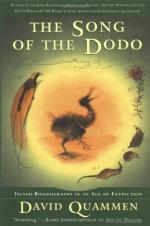
|
| Name: _________________________ | Period: ___________________ |
This test consists of 15 multiple choice questions and 5 short answer questions.
Multiple Choice Questions
1. What was Lovejoy's strategy in his plan?
(a) To diminish the size of nature reserves and track the number of species over time.
(b) Count the number of species in rainforest islands.
(c) To exterminate all animals in an area and study how the area was repopulated.
(d) To import animals into nature reserves.
2. How many individuals were thought to be necessary to prevent harmful inbreeding?
(a) 500.
(b) 50.
(c) 5,000.
(d) 200.
3. How does Quammen describe the indri?
(a) Reclusive.
(b) Impulsive.
(c) Amicable.
(d) Extroverted.
4. How long did Wilson and MacArthur predict it would take for species to reach equilibrium on Krakatau?
(a) 50 years.
(b) 75 years.
(c) 100 years.
(d) 40 years.
5. What had happened to the smaller reserves in Lovejoy's plan?
(a) They arrived at an equilibrium with a higher density than some larger reserves.
(b) They swelled with species.
(c) They unraveled quickly.
(d) They took longer to arrive at an equilibrium of species.
6. What habitats did researchers have to examine in the Texas case?
(a) Wetlands.
(b) Deep sections in the water.
(c) Riffles.
(d) Hillsides for burrows.
7. What factors did Simberloff and Abele cite in their challenge to Wilson and MacArthur's hypothesis?
(a) Size change and relictualism.
(b) Competition dispersal ability and number of species.
(c) Adaptive radiation and endemism.
(d) Competition and adaptation.
8. What risky move did Carl Jones make to save the Mauritius kestrel?
(a) Incubating wild eggs in his lab.
(b) Trying to crossbreed Mauritius kestrels with North American kestrels.
(c) Taking Mauritius kestrel DNA into a laboratory, and trying to inject into other birds' eggs.
(d) Placing Mauritius kestrel eggs in other birds' nests.
9. How did Quammen make his way to this site?
(a) By ascending a rope.
(b) By descending into a cave.
(c) On foot.
(d) By boat.
10. How was the minimum viable population theory applied in Texas?
(a) Officials wanted to know if a dam would destroy too much habitat for an endangered snake.
(b) Officials wanted to know how many invasive fish they would have to kill off to collapse the population.
(c) Officials wanted to determine how much development could take place without damaging the viability of a species of water bird.
(d) Officials wanted to create an open season for hunting mountain lions.
11. What did William Newmark determine in his findings?
(a) That species proliferate differently in different kinds of ecosystems.
(b) That species count and reserve area correlated.
(c) That species count and reserve area are not always correlated.
(d) That the number of species is less valuable than the number of predators in indicating the health of an ecosystem.
12. Who confirmed to Quammen that this site in fact existed?
(a) Natives.
(b) Wallace.
(c) Researchers on the island.
(d) His graduate assistant.
13. How did the data from Krakatau match Wilson and MacArthur's predictions?
(a) Roughly.
(b) Hardly.
(c) Not at all.
(d) Closely.
14. What does Quammen say the indri's future looks like?
(a) Likely extinction.
(b) Probable recovery.
(c) Quammen says it is uncertain.
(d) Expansion of territory and population.
15. What point does Quammen make by describing his sighting of the species he sought on Aru?
(a) That magnificent species survive in spite of human activity.
(b) That it is just a matter of time before these animals are extinct.
(c) That extinction is looming not only for this species but for the entire ecosystem it lives in.
(d) That species are in danger regardless of their magnificence.
Short Answer Questions
1. What was going to happen to the species' habitat as the Texas plan was implemented?
2. Who is Bedo?
3. What distinguished this species for Quammen? Wallace had discovered it there a hundred years ago. Darwin had developed his theory of evolve from observing it. Englishmen had lost their fortunes hunting for specimens.
4. Whose reactions does Quammen record, in relation to Bedo's death?
5. What does Quammen say increases as individuals breed with genetically similar individuals?
|
This section contains 690 words (approx. 3 pages at 300 words per page) |

|




